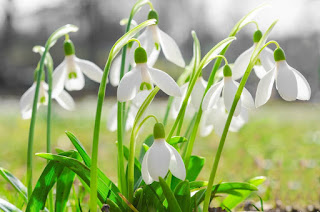
Snowdrop is a herbaceous plant in the Amaryllidaceae family. Snowdrops are native to Europe and Asia Minor, and there are 20 different species. Snowdrops grow in forests, grasslands, along streams, and along roads. They are frequently seen in gardens and parks. Snowdrops prefer well-drained, fertile soil and habitats with full or partial sun. Snowflakes and snowdrops are closely related. These two plants have similar flowers, but they bloom at different times of the year (snowflakes appear later in spring or even during the summer). The uncontrolled collection of plants from the wild is endangering snowdrops. Some snowdrop species are listed as vulnerable or even endangered.
Snowdrop is a small plant that can grow to a height of 2.7 to 12 inches.
The bulb of the snowdrop produces two to three narrow, dark green leaves. The leaves are usually 6 inches long and have enforced tips that allow them to grow through the snow.
A single flower blooms at the top of a flowering stalk. The flower is loosely hung and has a bell-like shape.
The perianth is made up of six tepals. The three outermost are larger and convex in shape. 3 inner are twice as long and have a small green notch at the top. Snowdrops have a pleasant, sweet odor.
During the months of February and March, bees pollinate snowdrops.
Snowdrop cross-pollination is uncommon due to low insect activity during the cold winter months. As a result, snowdrops seldom produce seeds, and the majority of plants are sterile.
Ants are attracted to substances produced by miniature white seeds. These insects use underground tunnels to collect and transfer seed.
The majority of snowdrops reproduce by division of the underground bulb.
Galanthus nivalis is the scientific name for the snowdrop. The name is derived from the Greek words “gala” (milk) and “anthos” (flower). The second part of the name, “nivalis,” comes from Latin and means “snow.”
Galanthophiles are a group of enthusiastic snowdrop collectors.
Galanthamine is a snowdrop-derived substance that can be used to improve sleep.
Galantamine can also be used to treat Alzheimer’s disease. It is sold under the brand name Reminyl. According to the most recent scientific research, galanthamine improves the function of certain receptors in the brain.
Snowdrops herald the arrival of spring. They are among the first plants to emerge while the ground is still covered in snow.
Snowdrops are a symbol of comfort and hope, as well as purity and cleansing.
During 2012, the 20th species of snowdrop was discovered for the first time. This species is extremely rare, and it can only be found in a few locations in Georgia and Russia. Unfortunately, one of its natural habitats was destroyed during the Olympic Games in Sochi preparations.
Snowdrop is a perennial plant, which means it can live in the wild for more than two years.








